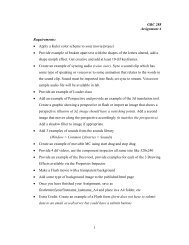Introducing Financial Accounting - CCSN Computer Graphics Program
Introducing Financial Accounting - CCSN Computer Graphics Program
Introducing Financial Accounting - CCSN Computer Graphics Program
You also want an ePaper? Increase the reach of your titles
YUMPU automatically turns print PDFs into web optimized ePapers that Google loves.
wiL27041_ch01_002-047.indd Page 19 10/4/10 7:12:39 PM user-f499 /Volumes/204/MHBR211/wiL27041_disk1of1/0073527041/wiL27041_pagefiles<br />
Chapter 1 <strong>Introducing</strong> <strong>Financial</strong> <strong>Accounting</strong> 19<br />
accounting equation. For example, in transactions 2, 3, and 9, one asset increased while another<br />
asset decreased by equal amounts.<br />
Quick Check Answers — p. 28<br />
17. When is the accounting equation in balance, and what does that mean?<br />
18. How can a transaction not affect any liability and equity accounts?<br />
19. Describe a transaction increasing equity and one decreasing it.<br />
20. Identify a transaction that decreases both assets and liabilities.<br />
FINANCIAL STATEMENTS<br />
This section introduces us to how financial statements are prepared from the analysis of business<br />
transactions. The four financial statements and their purposes are:<br />
1. Income statement — describes a company’s revenues and expenses along with the resulting<br />
net income or loss over a period of time due to earnings activities.<br />
2. Statement of retained earnings—explains changes in retained earnings from net income<br />
(or loss) and from any dividends over a period of time.<br />
3. Balance sheet — describes a company’s financial position (types and amounts of assets,<br />
liabilities, and equity) at a point in time.<br />
4. Statement of cash flows — identifies cash inflows (receipts) and cash outflows (payments)<br />
over a period of time.<br />
We prepare these financial statements, in this order, using the 11 selected transactions of<br />
FastForward. (These statements are technically called unadjusted — we explain this in Chapters<br />
2 and 3.)<br />
Income Statement<br />
FastForward’s income statement for December is shown at the top of Exhibit 1.10. Information<br />
about revenues and expenses is conveniently taken from the Equity columns of Exhibit 1.9.<br />
Revenues are reported first on the income statement. They include consulting revenues of $5,800<br />
from transactions 5 and 8 and rental revenue of $300 from transaction 8. Expenses are reported<br />
after revenues. (For convenience in this chapter, we list larger amounts first, but we can sort<br />
expenses in different ways.) Rent and salary expenses are from transactions 6 and 7. Expenses<br />
reflect the costs to generate the revenues reported. Net income (or loss) is reported at the bottom<br />
of the statement and is the amount earned in December. Stockholders’ investments and dividends<br />
are not part of income.<br />
Statement of Retained Earnings<br />
The statement of retained earnings reports information about how retained earnings changes<br />
over the reporting period. This statement shows beginning retained earnings, events that increase<br />
it (net income), and events that decrease it (dividends and net loss). Ending retained<br />
earnings is computed in this statement and is carried over and reported on the balance sheet.<br />
FastForward’s statement of retained earnings is the second report in Exhibit 1.10. The<br />
beginning balance is measured as of the start of business on December 1. It is zero because<br />
FastForward did not exist before then. An existing business reports the beginning balance<br />
equal to that as of the end of the prior reporting period (such as from November 30). Fast-<br />
Forward’s statement shows the $4,400 of net income earned during the period. This links the<br />
income statement to the statement of retained earnings (see line 1 ). The statement also reports<br />
the $200 cash dividend and FastForward’s end-of-period retained earnings balance.<br />
Point: Knowing how financial<br />
statements are prepared improves our<br />
analysis of them. We develop the skills<br />
for analysis of financial statements<br />
throughout the book. Chapter 13<br />
focuses on financial statement analysis.<br />
P2<br />
Identify and prepare basic<br />
financial statements and<br />
explain how they interrelate.<br />
Point: Net income is sometimes called<br />
earnings or profit.<br />
Point: The statement of retained<br />
earnings is also called the statement of<br />
changes in retained earnings. Note: Beg.<br />
Retained Earnings 1 Net Income 2<br />
Dividends 5 End. Retained Earnings









